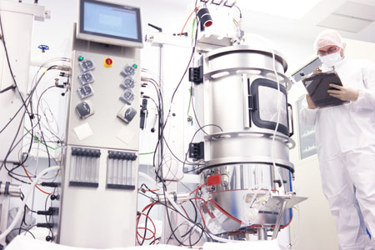Single-Use Bioreactors Gain Popularity Worldwide
By Sabyasachi Ghosh, Future Market Insights

Industry momentum is trending in favor of single-use bioreactors as a plurality of biopharmaceutical companies are opting for the disposable version of bioreactors, according to our new market research. This change in direction motion is largely underpinned by the fact that disposable or single-use bioreactors employ pre-sterilized bioprocess bags. Thus, they curtail the period of sterilization and any associated additional costs. Let’s look more deeply at the market insights, including additional factors that are influencing this industry swing.
Emerging Trends Driving Higher Adoption of Single-use Bioreactors
- With substantial headway made in automation and control systems, control over single-use bioreactor processes is improving, and monitoring is becoming more precise. Such progress elevates the product quality and lowers the need for manual interference.
- There is a surging preference for continuous bioprocessing as a substitute for batch processing. Disposable bioreactors are being deployed in continuous manufacturing as they offer the benefits of scalability, efficiency, and product quality.
- Single-use bioreactors have been instrumental in the production of cell and gene therapy. These bioreactors assist in the manufacturing of gene-edited cells and viral vectors. Since the field of cell and gene therapy is flourishing, the demand for bioreactors is expected to continue expanding.
- Single-use bioreactor management is less expensive on the mechanical end as these models feature fewer mobile parts than traditional bioreactors. Their enhanced affordability over the long run is boosting their adoption among academic and research institutes, CROs, and CMOs.
- When purchasing disposable bioreactors, factors like cost, desired operating volume, reactor size, capacity, dimensions, and temperature control are the main considerations. Armed with this knowledge, bioreactor manufacturers are zeroing in on customized single-use bioreactors that best suit the evolving demands of end users.
- Single-use bioreactor technology provides heightened facility flexibility at reduced investment and energy costs, including fast setup and lowered validation time, so it is a favored choice for biotechs seeking expeditious scaling up of production. Furthermore, disposable bioreactor technology makes elaborate and manpower-intensive cleaning processes redundant when adhering to good manufacturing Practice (GMP) guidelines.
- The Single-use media bags are in extensive demand since they maintain aseptic conditions and lower the risk of contamination. Biopharmaceutical manufacturers recognize the benefits of eradicating the steps of sterilization and cleaning for operational efficiency, thus fueling the adoption of single-use bioreactors.
- Demand for single-use filtration assemblies is motivated by the increasing demand for reliable and efficient downstream bioprocessing like sterile filtration, clarification, and virus removal.
Demand Drivers For Different Types of Disposable Bioreactors
- The stirred-tank SUBs are widely deployed in the development of biological drugs and other biotechnology-related products. The gentle agitation provided by wave-induced motion bioreactors makes them fit for virus production, adherent cell cultures, and processes necessitating low-shear mixing.
- Bubble column SUBs are developed for aerobic fermentation processes, offering effective agitation and oxygen transfer. Their demand is increasing, particularly in industries that utilize aerobic fermentation.
Market Development Across Geographical Boundaries
Biotechs based in the United States are using single-use bioreactors to expand their production capacity. Notably, research on human stem cells has exhibited positive results by using disposable bioreactors for regenerative medicine approaches. Bioreactor providers in the U.S. region are constantly enhancing single-use bioreactors, like updating the throwaway container installation hoist, and executing customer-specific modifications to meet operational needs and certain processes, thus boosting the uptake of disposable bioreactors.
The Canadian biotech industry is increasingly using single-use bioreactors as well. Manufacturers are flocking to the country to set up or expand their bioreactor capacity in the country, and international partners count Canada as a profitable manufacturing destination. Mounting investments in domestic biomanufacturing are also a crucial factor. Key companies in the market are offering an exhaustive bioreactor portfolio, featuring scalability from research and cGMP production. To support biopharmaceutical applications, leading players are providing a gamut of bioreactors that are best suited for microbial fermentation applications and mammalian cell culture.
In India, the use of single-use bioreactors is growing quickly. The market growth in the country is being spearheaded by the surging production and development of vaccines and biological drugs. Sales of biosimilar products are occurring at a rapid pace in the Indian market, catalyzed by the surging demand for lower-cost medicines. Additionally, the intensive and dedicated marketing initiatives to propel sales of biosimilars are also pushing product sales.
The U.S. is expected to retain its position as a frontrunner for using single-use bioreactors through the end of our market research forecast period (2033), followed by Canada, followed by the emerging biotech industry in Asian countries such as Japan and India.
Prominent Single-Use Bioreactor Vendors
Companies operating in the space include Applikon Biotechnology BV, Cellexus Ltd., Danaher Corporation, Cesco Bioengineering Co. Ltd., Celltainer Biotech B.V., MarqMetrix, and Cytiva.
Many are forming partnerships, collaborating with CMOs, or focusing on mergers and acquisitions to consolidate the market and further obtain corresponding technologies or expertise. Larger companies can strategically engulf relatively small companies or startups equipped with complex technologies to give a boost to their product portfolios. Prominent players are also investing in the fortification of their training services and customer support to boost the adoption and deployment of single-use bioreactors.
Recent developments in the market are:
- In August 2023, Repligen and Sartorius introduced an integrated bioreactor system that integrates Repligen’s XCell ATF upstream intensification technology with Sartorius’ Biostat STR bioreactor. The major focus of this development is to streamline N perfusion implementation and intensify seed train for biopharmaceutical manufacturers.
- In April 2023, Cytiva, an American-based company, declared the launch of X-platform bioreactors to streamline the single-use upstream bioprocessing operations. These bioreactors, first available in 50 L to 200 L sizes, are delivered with Figurate automation solution software. They can also boost process efficiency via production capability, ergonomic improvements, and streamlined supply chain operations.
- In July 2023, Trelleborg introduced BioPharmaPro's range of innovative products, services, and materials for fluid path single-use equipment. These solutions are developed from an extensive line of materials, such as thermoplastics, silicones, other elastomers, and composites, which can produce custom molded components, tubing, and processing columns up to full assemblies.
- In March 2022, Cellexus International launched a throwaway airlift bioreactor that assists scientists to expeditiously and cost-effectively grow delicate cell cultures for their study. The Cell Maker single-use airlift bioreactors create bubbles that filter through the mixture, thus providing a tender mixing action for fragile cell cultures.
- In March 2021, Thermo Fisher launched 3,000 L and 5,000 L single-use bioreactors with capacities beyond the standard limits. This development was in response to substantial demand from CDMOs and pharmaceutical companies for different sizes of new systems. These systems deliver higher scalability, an enhanced turndown ratio, and better mixing.
- In February 2021, WuXi Biologics, a leading provider of open-access biologics technology platforms, reported that its MFG5 Drug Substance (DS) manufacturing unit in China has introduced GMP operation. The unit has a volume capacity of 36,000 L, utilizing nine 4,000 L disposable bioreactors.
About The Author:
 Sabyasachi Ghosh is associate vice president of healthcare, medical devices, and pharmaceuticals at Future Market Insights. He has more than 12 years of experience in the industry and has been a researcher since the start of his career. His core expertise is in market entry and expansion strategy, feasibility studies, competitive intelligence, and strategic transformation. He holds a B.Sc. in microbiology. You can connect with him on LinkedIn.
Sabyasachi Ghosh is associate vice president of healthcare, medical devices, and pharmaceuticals at Future Market Insights. He has more than 12 years of experience in the industry and has been a researcher since the start of his career. His core expertise is in market entry and expansion strategy, feasibility studies, competitive intelligence, and strategic transformation. He holds a B.Sc. in microbiology. You can connect with him on LinkedIn.
